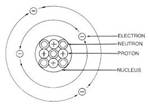
Concept explainers
Interpretation:
A modern atomic model of atom containing different types of subatomic particle needs to be sketched.
Concept introduction:
Atom is the fundamental building block of the matter. In the universe, the elements, molecules, compounds, and solid, liquid gases etc. all these things are made up from atoms. Three main subparticles of an atom are:
1. Protons.
2. Neutrons.
3. Electrons.
Answer to Problem 113A
The atom is made from three small sub particles, namely protons, neutrons and electrons.
Explanation of Solution
Atom is just like a sphere like structure where protons and neutron present in the nucleus of the atom and electrons revolving around the nucleus.

The protons, neutrons and electrons are classified by the following important key points.
Protons − Protons are found in nucleus of an atom.
Protons are positively charged sub particles.
The number of protons and the number of electrons are equal in an atom.
The mass of a proton is 1.67×10-24 g.
The charge of the protons is +1.602×10-19 coulombs.
Electrons − Electrons are revolving around the nucleus. The electrons remove from or gain by an atom to form ion. Electrons are participated in the
Electrons are negatively charge sub particles.
The mass of an electron is negligible.
The charge of electrons is equal to -1.602×10-19 C.
Neutrons − Neutrons are present along with protons in the nucleus, which make up the nucleons.
Neutrons are named for their neutral nature.
Neutrons are neutrally charged.
The mass of the neutrons is -1.67×10-24g.
It concluded that protons are positive in nature and electrons are negative in nature while neutrons are neutral in nature. Also, the mass of electron is negligible as compared to mass of proton and neutron.
Chapter 4 Solutions
Chemistry: Matter and Change
Additional Science Textbook Solutions
Essential Organic Chemistry (3rd Edition)
CHEMISTRY-TEXT
Chemistry: Structure and Properties (2nd Edition)
General, Organic, and Biological Chemistry (3rd Edition)
Organic Chemistry (9th Edition)
Chemistry: A Molecular Approach
 ChemistryChemistryISBN:9781305957404Author:Steven S. Zumdahl, Susan A. Zumdahl, Donald J. DeCostePublisher:Cengage Learning
ChemistryChemistryISBN:9781305957404Author:Steven S. Zumdahl, Susan A. Zumdahl, Donald J. DeCostePublisher:Cengage Learning ChemistryChemistryISBN:9781259911156Author:Raymond Chang Dr., Jason Overby ProfessorPublisher:McGraw-Hill Education
ChemistryChemistryISBN:9781259911156Author:Raymond Chang Dr., Jason Overby ProfessorPublisher:McGraw-Hill Education Principles of Instrumental AnalysisChemistryISBN:9781305577213Author:Douglas A. Skoog, F. James Holler, Stanley R. CrouchPublisher:Cengage Learning
Principles of Instrumental AnalysisChemistryISBN:9781305577213Author:Douglas A. Skoog, F. James Holler, Stanley R. CrouchPublisher:Cengage Learning Organic ChemistryChemistryISBN:9780078021558Author:Janice Gorzynski Smith Dr.Publisher:McGraw-Hill Education
Organic ChemistryChemistryISBN:9780078021558Author:Janice Gorzynski Smith Dr.Publisher:McGraw-Hill Education Chemistry: Principles and ReactionsChemistryISBN:9781305079373Author:William L. Masterton, Cecile N. HurleyPublisher:Cengage Learning
Chemistry: Principles and ReactionsChemistryISBN:9781305079373Author:William L. Masterton, Cecile N. HurleyPublisher:Cengage Learning Elementary Principles of Chemical Processes, Bind...ChemistryISBN:9781118431221Author:Richard M. Felder, Ronald W. Rousseau, Lisa G. BullardPublisher:WILEY
Elementary Principles of Chemical Processes, Bind...ChemistryISBN:9781118431221Author:Richard M. Felder, Ronald W. Rousseau, Lisa G. BullardPublisher:WILEY





